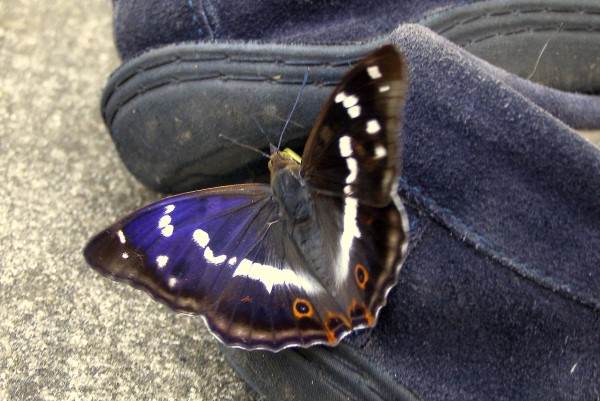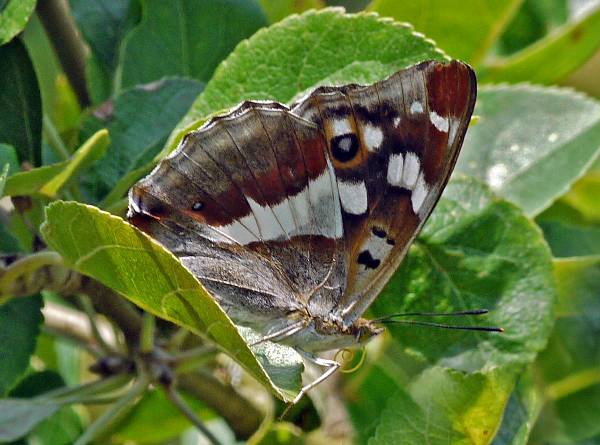Purple Emperor Butterfly - Apatura iris
Phylum: Arthropoda - Class: Insecta - Order: Lepidoptera - Family: Nymphalidae

Purple Emperors are not a common sight, partly because of their shyness and scarcity but also because of their habit of spending most of the day in trees (particularly oaks) well above head height.
Description
With a wingspan of 7 to 8cm, males of this beautiful butterfly species and its close relative the Lesser Purple Emperor are able to display iridescent blue-purple hues, dependent on the directions of incident and reflected light. Unlike chemical pigments, the emperor's wings are studded with strongly reflecting iridescent scales that diffract light, and this results in a narrow-frequency-band reflected spectrum that is visible only in a narrow angular range.
The wings have a dark-brown background with white bands and spots and a small orange ring on each hindwing, and in males the wings display a blue-purple iridescence when viewed from a particular angle.
On the forewing leading edge there are two groups of white spots, and there is a large orange-ringed eyespot on the brown underside of each forewing.
In the middle of hindwing, which is more deeply scalloped than the forewing, there is a long white band, while on the upperside towards the trailing edge a single light-brown ring is not replicated on the underside. The body is greyish and almost black on top.

Above: closed-wing view of a Purple Emperor butterfly in the top of an apple tree
Females are very similar to the males but slightly larger, with a wingspan 8 to 9.2cm, and their wings have no blue-purple iridescence.
In hot weather these butterflies spend most of the time high up in trees, often resting on oak leaves and making photography almost impossible; however, the males are attracted towards human perspiration, and sometimes they congregate to drink from moist animal dung.

Distribution
This lovely butterfly is native to Britain, where its colonies are restricted to a few locations in central southern England. Its range on mainland Europe includes a few locations in northern Portugal and northern Spain, and it is more plentiful across most of central and northern Europe except Scandinavia. This species is absent from southern Italy and the Mediterranean islands.
Habitat
The Purple Emperor is a butterfly of mature broad-leaved woods and forests, where it can bee seen in clearings and along tracks that are bordered by willow trees, its larval food plants.
Lifecycle
The Purple Emperor is univoltine and can be seen on the wing between mid June and mid August. The larval food plants are various willows, including Salix alba and Salix caprea. The females lay their eggs singly, usually one to two metres above the ground, on the uppersides of the leaves of host trees. Like its relative the Lesser Purple Emperor, this species overwinters as young larvae.
Studying butterflies and moths...
Acknowledgements
This page includes pictures kindly contributed by Steve Jelf and Tony Rackham.
Excited at the prospect of flyfishing? So are we, and we're pretty sure you would find the Winding River Mystery trilogy of action-packed thrillers gripping reading too. Dead Drift, Dead Cert, and Dead End are Pat O'Reilly's latest river-and-flyfishing based novels, and now they are available in ebook format. Full details on our website here...
Buy each book for just £4.96 on Amazon...
Please Help Us: If you have found this information interesting and useful, please consider helping to keep First Nature online by making a small donation towards the web hosting and internet costs.
Any donations over and above the essential running costs will help support the conservation work of Plantlife, the Rivers Trust and charitable botanic gardens - as do author royalties and publisher proceeds from books by Pat and Sue.
